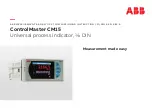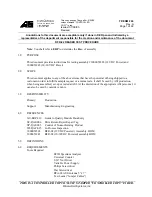
22
Warner Electric • 800-825-9050
P-0257-WE • 819-9027
Using a voltmeter, check the DC voltage at the brake terminals as follows: Slowly
raise the dancer and observe that the voltage decreases then slowly lower the
dancer and observe that the voltage increases. If the voltage indications are the
opposite, reverse the sensor leads at terminals 5 and 7 of the control (see sensor
wiring).
If no voltage change occurs, check sensor cable connections (check pivot point
coupling: connection if MCS-605-1 or TCS-605-5 sensor is used).
If no voltage change occurs, be sure that the brake wires are not grounded to
machine.
Symptom C: Dancer moves to and remains at upper limit after operating In a normal running position for a
period of time.
Probable Cause
Suggested Solution
Incorrect Dancer Position setting
Adjust dancer position setting until dancer moved to normal running position.
Dancer pivot point sensor coupling has slipped If dancer position adjustment lowers the arm near its normal running position,
realign pivot point sensor (see sensor mounting).
Faulty P.C. Board
With dancer position and gain at minimum setting, check that the voltage on the
brake terminal reduces to less than two volts as the dancer arm is raised. If voltage
does not reduce to less than two volts, replace printed circuit board assembly.
(Problem occurs near roll core only) Residual
torque of the unwind stand exceeds the
minimum torque allowable for the application.
With dancer position and gain at minimum setting, check that the DC voltage
at the brake terminals reduces to 0 and reverses polarity as the dancer arm is
slowly raised. If the voltage reduces and reverses polarity, check to be sure that
the brake is in good operating condition and properly installed (see tension brake
maintenance-torque loss). Also check to be sure that the unwind stand friction
is not excessive for the application. Check the brake selection procedure to be
sure the brake being used does not exceed the minimum allowable torques, if the
voltage did reduce to zero but did not reverse polarity, adjustment of the antiresidual
may be necessary, If adjustment of the antiresidual does not cause the brake
voltage to reverse polarity in the off state, replace the PC Board Assembly.
Symptom D: Dancer moves erratically - appears to hunt or oscillate.
Probable Cause
Suggested Solution
Incorrect Dancer Gain setting
Adjust dancer gain setting CCW until dancer stops hunting.
Nonuniform system friction
If the hunting coincides with each revolution of the web parent roll, check faulty
bearings or mismounted brake.
Improperly installed sensor
When an MCS-605-1 Sensor is being used, check to be sure the index mark on the
sensor shaft is aligned with the index mark on the sensor body when the dancer
is at the mid-travel position. Also, be sure there is no lag between the movement
of the dancer pivot point and the shaft of the sensor - the sensor shaft must move
when the dancer pivot moves. With dancer centered, voltage at terminals 6 and 7
should be 7.5 VDC ±0.1 VDC (refer to the sensor mounting section).
Loose or faulty sensor and cable assembly.
Check to be sure that all connections to the control terminal block and the brake
wire connections are secure. Check electrical connector at sensor to be sure it is
not loose. Using a DC voltmeter connected between control terminals 6 and 7,
check to be sure the voltage variation is smooth as the dancer is slowly moved
through its travel limits. If the voltage variation is not relatively smooth, either the
sensor or cable assembly is faulty. To isolate the fault to the cable or the sensor,
turn off power and disconnect the cable from the sensor and connect an ohmmeter
between the middle pin and one of the remaining pins on the sensor receptable.
The resistance indication should vary smoothly as the dancers moved through
its travel limits. If the indication is erratic, the sensor should be replaced; if the
indication is not erratic, the cable assembly should be replaced. If above steps
seem normal, recheck dancer arm length (most applications require a dancer arm at
least 12” long).



































